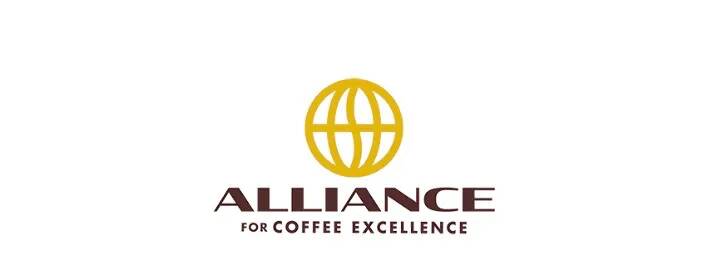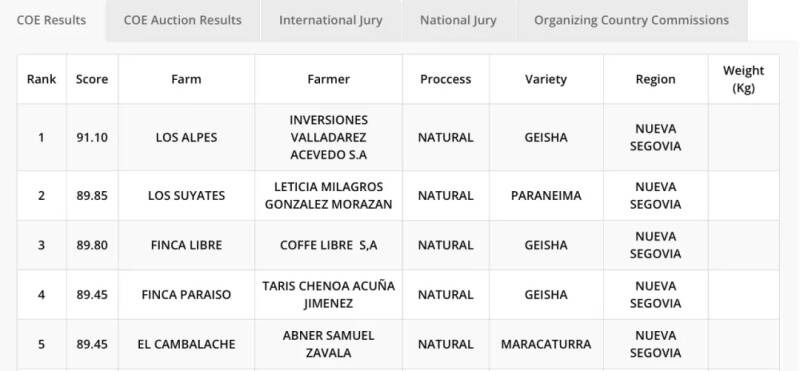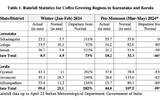2024 Nicaragua COE results are released! Introduction to the Parainem Variety of Parainema
COE, whose full name is "Cup of Excellen" and translated as Excellence Cup, is the first coffee competition held in Brazil in 1999 by the non-profit organization Coffee Excellence (ACE). It is also the first global Internet auction platform for award-winning coffee.

And every country can bid for the COE competition, and the beans are produced from all over the host country, through the cup test (blind test) to score the competition, and after the competition, the winning coffee beans will be auctioned, which will make the winning manor have enough reputation and considerable auction revenue.
Recently, the result of the COE Cup in Nicaragua was announced in 2024. In this competition, there are many varieties, including Rosa (Geisha), Palayinema (Parainem), Maraka Dula (Maracaturra), Pacamara (Pacamara) and so on.

Among the top five, Rosa Geisha won the first, third and fourth places, and the first Rose Summer also scored 91.10 points.
However, the more prominent is the second place with a score of 89.85. it is a relatively rare variety, Palayinema (Parainem). Although rare, the variety won the first place in the 2017 Honduras Excellence Cup COE with a score of 91.81.
Later, he also made an appearance in the COE of Honduras in 2023, but his grades were mediocre and his fame lagged behind. Now, it appears again, but this time it is at the COE competition in Nicaragua, and it is the first time it appears in Nicaragua.
Palayinema (Parainem)
The Palayinema variety is related in pedigree to T5296 Sachimo and was selected from T5296 by the Honduran Coffee Institute (IHCAF É).
T5296 originated from a Central American regional alliance called PROMECAFE, which was founded in 1978 and funded by the Central American Project Regional Office (ROCAP) of the United States Agency for International Development (USAID) and the Brazilian Institute of Agricultural Research (IAC) to deal with the threat posed by coffee leaf rust to the region.
Later, the Portuguese Research Institute (CIFC), known for studying coffee leaf rust, received many Timor seeds from Timor (a natural hybrid of Arabica and Robusta).
CIFC selected two coffee trees with strong resistance to leaf rust from these seeds for breeding, and one of them, called HDT CIFC 832max 2, crossed with the compact variety Villa Sarchi (Vera Saatchi) to produce H361, also known as Sarchimor Sachmo.
Later, because of the PROMECAFE program, H361 was sent to the Tropical Agricultural Research Center (CATIE) in Costa Rica for breeding screening, while the researchers named "H361"T5296" (T stands for Turrialba, where CATIE is located) and then distributed it to other American countries.
In Honduras, IHCAFE selected T5296 and finally got a qualitative variety of Parainema coffee. The variety is resistant to leaf rust and nematodes. The new leaves at the top are green, tree-shaped and short, and can be planted densely. Coffee beans are large and slender.
However, for a long time, some buyers have not been interested in these varieties that are resistant to leaf rust because of their low cup test quality, so this COE may break these prejudices.
Important Notice :
前街咖啡 FrontStreet Coffee has moved to new addredd:
FrontStreet Coffee Address: 315,Donghua East Road,GuangZhou
Tel:020 38364473
- Prev

India's coffee production is stable, but there are still many crises such as weather and shipping that affect production and exports in the new season.
Recently, the U.S. Department of Agriculture released its annual Indian coffee report, which pointed out in the report that India's coffee production in the 2024/25 marketing year is expected to be approximately 6 million bags of 60 kg coffee beans, of which Arabica is estimated to be 1.4 million bags of 69 kg coffee, and Robsta estimates 4.6 million bags of 60 kg coffee.
- Next

Municipal Supervision Bureau intervened! The moldy incident of Ruixing ice cubes has attracted attention from many parties
▲ Click to pay attention| In the past two days, the issue of "Ruixing Coffee was exposed to ice cubes and mold" has become a hot topic on the Internet. During this period, it once became a hot search topic, attracting attention from all parties. The cause of the incident originated from a video. The customer in the video, Mr. Wang, stands in Qichun, Huanggang, Hubei
Related
- Being chased out of the rain in front of Starbucks?! Store: Sheltering from rain under umbrellas poses a safety hazard
- The white moonlight has changed?! Lucky launches "Big Winter Pear American"
- Hand-brewed coffee three-stage method, high-sweet and universal brewing method to share! What does the high sweet water level of hand-brewed coffee mean?
- What is the difference between raw, refined and full espresso coffee? How to extract espresso and taste good?
- A complete list of coffee bean names and their meanings! What is Yejia Shefi coffee? Where is Mantelin coffee?
- What grade does Arida Manor Kaduai coffee beans belong to? What treatment is Arida ASD slow anaerobic sun exposure?
- The milk tea cup becomes smaller?! Overlord Tea Girl launches a new "Return to Yunnan" series
- Accused of selling counterfeit and high-priced coffee beans! Well-known boutique coffee brand "Oukelao" bowed and apologized!
- How to make espresso dumplings? Can I eat coffee and glutinous rice balls together?
- Save the unformed and stagnant powder cakes in one second! What is the problem with stagnant water in the powder bowl of the espresso machine?

